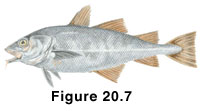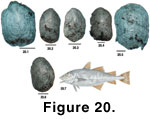 Description
DescriptionGadus macrocephalus
(Pacific Cod)
(Other common names: True Cod, Gray-Cod, Cod)
Figure 20.7
 Description
DescriptionLength: 114 cm.
Mouth: moderate, terminal; maxillary extends to mid-pupil; teeth are small and sharp.
Body: elongate; three separate dorsal fins, two anal fins with first beginning below front of second dorsal fin, caudal fin truncate (but slightly indented); barbel is about equal in length to the eye diameter; lateral line high anteriorly, dipping mid-body.
Color: brown to gray on dorsal side with numerous brown spots or pale areas on back and side; lighter on ventral side; fins somewhat dusky with dorsal, caudal, and anal fins usually white-edged.
Depth: up to 550 m; undergo seasonal migrations tending to concentrate on the shelf edge and upper slope (100-250 m) in the winter and moving to shallower waters (generally <100 m) in the summer.
Habitat: generally benthic on sandy/muddy substrate.
Season: spawn in winter; eggs hatch in from 8 to 17 days depending on temperature.
Diet: benthic crustaceans, forage fish species (herring, sand lance, flatfish).
Predators: seals and sea lions (Olesiuk, 1993).
Distribution: widely distributed in the coastal north Pacific, from the Bearing Sea to southern California, in the east, and to the Sea of Japan in the west; less common in southern waters. For management purposes four stocks of Pacific cod are defined on the British Columbia coast: Strait of Georgia, West Coast Vancouver Island, Queen Charlotte Sound, and Hecate Strait.
 Scale
Description
Scale
DescriptionRelative Scale Size: small.
Position of Scales on Body: not determined.
Overall Shape: the scale varies from semi-circular to oval (this can be somewhat exaggerated depending on how desiccated the scale is).
Focus and Circuli: the focus is not centralized between the four fields and is approximately one-third of the total length from the anterior margin. The focus and surrounding circuli are concentric. Circuli are generally continuous but in the leading edges of the fields, can be distorted or broken by the intermarkings.
Radii: there are no radii, however, there are distinct intermarkings (sensu Batts, 1964), which are perpendicular or irregular "ines/structures" between the circuli. These intermarkings can align between the circuli to give a loosely similar appearance to radii.